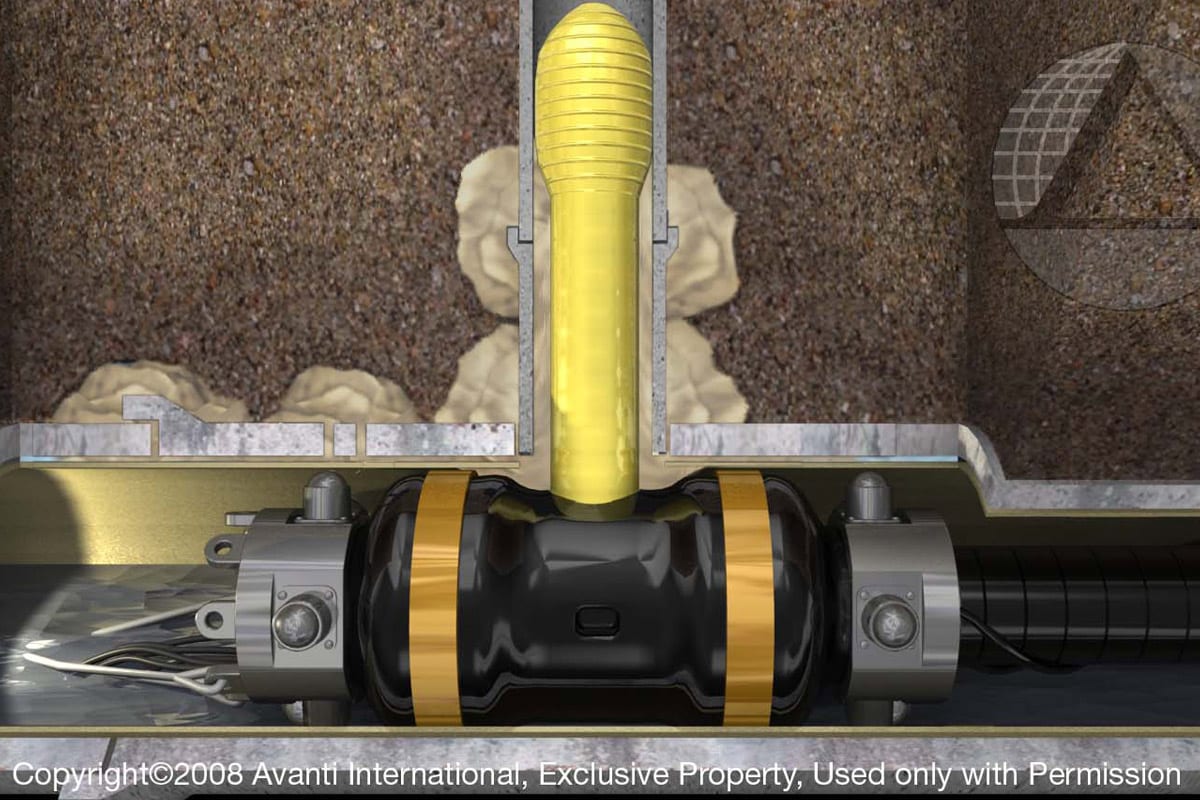Duke’s Root Control
 Operating a sewer system has never been easy, but today it is more difficult than ever. Add aging pipelines and a growing population to decreased budgets and increased regulations and it’s easy to see why.
Operating a sewer system has never been easy, but today it is more difficult than ever. Add aging pipelines and a growing population to decreased budgets and increased regulations and it’s easy to see why.
But there are more tools available today than ever to help sewer system stewards not only keep the system in peak operating condition, but also add value by increasing the lifespan of the pipe.
One such tool that is often overlooked is chemical root control. Modern chemical root control has evolved from what was once viewed as a “black magic” to a scientific, state-of-the-art treatment system that can extend the life of the pipes, as well as minimize or eliminate stoppages and overflows.
Getting the word out to sewer system owners about the value of chemical root control has been a slow process since the technology was first developed in the 1960s. Duke’s Root Control, a company whose origins in the residential and municipal piping market date back nearly 60 years, has been at the forefront of educating sewer system operators on the value of chemical root control treatment.
Why Chemical Root Control?
The presence of roots in municipal sewer lines has long been a problem for many sewer operators. In fact, the U.S. Environmental Protection Agency estimates that 43 percent of the sanitary sewer overflows nationwide are caused by pipe blockages, and about half of those blockages are the result of tree root intrusion into the sewer pipe.
Usually these roots enter the pipe through cracked joints, and it doesn’t take much of a crack. A root the size of human hair can find its way into the pipe – a rich source of nutrients and water.
Once inside the pipe, the root can create further damage to the pipe, creating offsets, further cracking and decreasing the lifespan of the pipe. Sometimes, these roots can indirectly cause stoppages by creating offsets that can trap grease or other materials.
The process of chemical root control works by mixing an herbicide with a surfactant and foaming agent and pumping the mixture into a sewer line segment. The foaming agent allows the herbicide to directly contact the roots, which grow above the waterline. The surfactant helps remove buildup from the root to allow for better contact with the herbicide.
The herbicide should contact the roots for a period of one hour, and after that roots in the sewer are dead, according to Mike Hogan, president of Duke’s Root Control. The next step is allowing the roots to decay and fall off, a process that normally takes anywhere from two to six months, Hogan says.
Hogan recommends a second treatment two years after the first, which kills roots farther outside the pipe and kills re-growth while it is still young. “On the first treatment we’re typically getting roots that are 30 to 50 years old. On the second treatment, you’re getting to roots with only a few months’ growth,” he says.
Many municipalities are familiar with mechanically cutting out roots, but Hogan says that this approach can end up leading to more costly problems in time. “When you use mechanical means to extract the roots,they grow back faster and fuller,” he says. “And you are only able to cut roots within the diameter of the pipe – the roots in the joints begin to grow back immediately.”
Roots in the Sewer Business
The predecessor to Duke’s Root Control was founded as Duke’s Plumbing and Heating in Syracuse, N.Y., by Alec Duke. The company prospered in the building boom in the aftermath of World War II, installing plumbing for many of the schools and public buildings being built in Syracuse. In the 1960s, Duke’s branched off into municipal sewer cleaning and rehabilitation and was one of the pioneers in utilizing hydraulic sewer cleaning, CCTV inspection and sewer joint sealing.
In 1975, the plumbing and municipal business segments branched off into different companies between Alec Duke’s sons,with the company serving the municipal market being named Duke’s Sales and Service. The company’s involvement with root control dates back to that time when it was a distributor of root control products and equipment.
Duke’s Sales and Service, which was being run by Kevin Duke (Alec’s son) and Tony Malavenda, soon discovered that municipalities weren’t eager to purchase chemical root control products and equipment due to concerns regarding the application of herbicides. Kevin Duke still serves as a company director, while Malavenda, also a director, leads the company’s research and development.
“The idea of chemical root control did not take off immediately,” explains Hogan, who started off in the sales side of the business. “There was a lot of skepticism from old-timers who still relied on tried-and-true mechanical methods or who had bad experience with one of the old pour-down chemicals that were sold for chemical root control.”
As a result, the company decided to change its approach and began focusing on contracting beginning around 1980. One of the biggest challenges for the upstart company was convincing people that not only was chemical root control effective, but that it was part of an overall operations and maintenance program.
The fleet at that time consisted of a pickup truck that doubled as a sales vehicle and service rig. Much of the time was spent doing demonstrations throughout the Northeast, slowly spreading the word about the value of chemical root control.
“Once the decision was made to offer root control as a service,we began to experience slow growth,” Hogan says. “It really wasn’t until the last 10 years that chemical root control really started taking hold.”
Today, Duke’s has applied chemical root control in more than 100 million ft of sewer pipe. The company, still headquartered in Syracuse, has satellite offices in Atlanta, Dallas and Oakland, Calif.
Experience Is the Key
Hogan points to the experience of Duke’s employees as the key to its success. The company has fostered a commitment to quality and professionalism – as well as to its employees – which has allowed it to limit turnover and pass the industry knowledge and quality application on to its customers.
While many companies today are searching for qualified personnel, Duke’s has been able to maintain its core leaders both in the field and with its sales force.
“We have project managers who have been here for 20, 25 years, ” Hogan says. “In fact, we don’t allow employees to run a crew until they have been here for three years and treated over one million feet. And the same holds true with our sales team; we have guys who have been with us for a very long time and have so much industry knowledge that they can share with the clients.”
Hogan says the key to maintaining an experienced workforce is being able to instill a sense of ownership within all of the Duke’s team. “All the employees of Duke’s are empowered to make decisions as to what is in the best interest for both the company and the project owner.”
Duke’s also has a made a commitment to research and development. In conjunction with Sewer Sciences, the R&D program works with Virginia Tech, Southern Illinois University and other research facilities in screening and testing for improved products. It was through this program that Duke’s developed its diquat-based herbicide for use in municipal wastewater systems.
“We were looking for a safer alternative [to other products on the market] and through our R&D program, we developed the diquat product, Razorooter II,” Hogan says. “It was an herbicide that had been used in aquatic applications and we modified it to suit the municipal market.”
One Agency’s Experience
The Washington Suburban Sanitary Commission (WSSC) spans two Maryland counties in greater Washington, D.C. With more than 5,300 miles of sewer, it is one of the largest sewer agencies in the United States. With roots being a problem, WSSC was looking for a safe chemical root control product and selected Duke’s based on what it had heard from other owners, says Dave Alexander, WSSC contract manager.
“We have a severe root problem,” he explains.“We have a lot of trees and a lot of old clay pipe that was put in the ground in the early 1990s. The roots were infesting the pipe and they were affecting our system tremendously.
“We started applications of chemical root control in the fall of 2005, and we have seen a drastic reduction in the number of main line backups, overflows and lateral backups into the home. We’ve done about 120 miles of chemical root control in our sewers, and we’re going to increase the program because of the success we’ve had to date.”
Alexander’s agency tracks a list of critical homes – homes that have had multiple backups within a certain timeframe. He says that the list, which had averaged between 275 and 350 homes, has been down to less than 100 over the last 12 months.
“The main thing this allows us to do is spend more time concentrating on other areas like grease,” Alexander says.
He says WSSC started out by treating the problem areas within the system, but is now treating basins.“ We’re going into a basin and treating every main regardless of whether there had been problems or not,” Alexander says. “The idea is to try to avoid any potential problems in the future.”
Looking Forward
The market for chemical root control is growing, according to Hogan, as more and more municipalities are taking a critical look at their systems. The recent implementation of GASB 34, which requires municipalities to better account for their underground infrastructure, as well as the EPA’s proposed CMOM regulations, have succeeded in starting to change the management philosophy from reactive maintenance to proactive or preventive maintenance.
“Cities in today’s environment are much more familiar with the condition of the pipes than ever before,” Hogan says. “They are identifying the areas that have problems and are addressing those areas.
“In addition, they should also be addressing the areas with lighter problems because those are the problem areas of the future. Not only can you address these areas before they create stoppages and overflows, but by treating them now you can avoid the structural damage to the pipes that roots can cause. That means, 20 years from now, you won’t be repairing or replacing that line and the future sustainability of the pipe will be preserved.”




